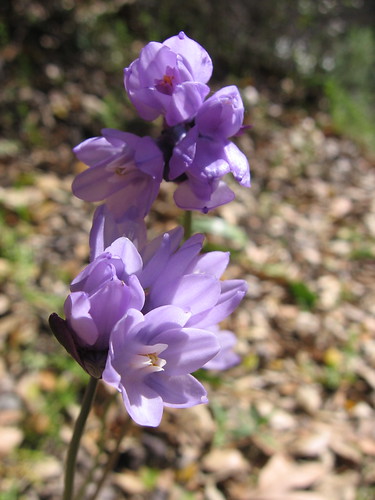Unfortunately for the prurient-minded, it has nothing to do with the teen-age male malady known as “blue balls.”
Because my fortysomething brain has frequent and severe bouts of CRS (can’t remember shit), I mistakenly called these things shooting stars in a couple captions at my Flickr account, an error an alert reader promptly noted and sent along this Wikipedia link:
Dichelostemma capitatum is an herbaceous perennial growing from an underground corm to a height of as much as 60 cm. It has 2–3 leaves which are 10–40 cm long. The inflorescence is head- or umbel-like, and dense. It usually contains 2 to 15 flowers, which have a blue, blue-purple, pink-purple, or white perianth. The flower tube is 3–12 mm and is narrowly cylindrical to campanulate. Flowers have six fertile stamens, deeply notched, lanceolate, white, angled inward, slightly reflexed at tip, with outer filaments wider at the base. It has a twisted and fleshy peduncle, a set of membranous, petal-like stamen appendages around the anthers, and angular black seeds. It reproduces from seed and vegetative means in the form of cormlets. The cormlets are attached to the parent corm by stolons and are sessile, produced in the axils of the old leaf bases on the mature corm. Plants thrive in open disturbed environments, and are a common post-fire succession species in chaparral.
Ah, that ol’ Dichelostemma. Wikipedia notes the seeds of these pretties are distributed through the bowels of woodland creatures like mule deer and gophers, and that native American peoples dined on the “corm” the plant produces.
Of course, now you won’t be able to giggle when you mention these flowers in the locker room.
Here’s a Flickr slide show of blue dicks.

